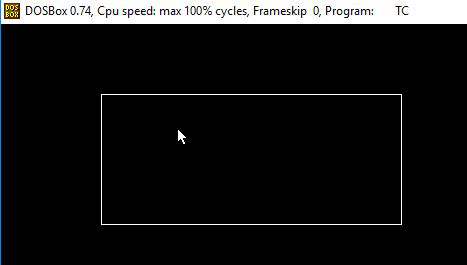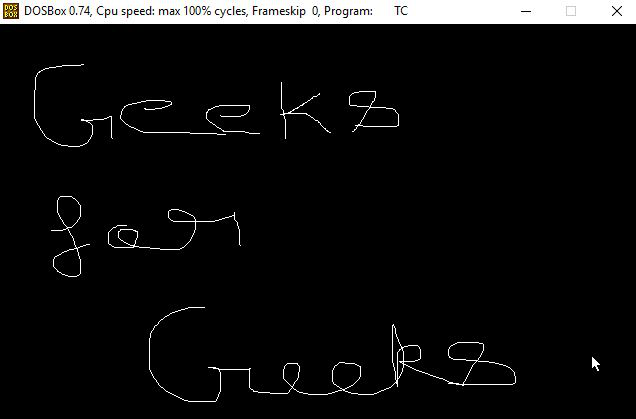En este artículo, discutiremos algunos casos de uso de la programación del mouse :
Restringir el puntero del mouse :
El puntero del mouse se puede restringir en un rectángulo particular. La idea es crear una función llamada restrictmouse() que tome cuatro parámetros que contengan la coordenada X y la coordenada Y. El primer punto menciona la parte superior del rectángulo y el segundo punto menciona la parte inferior del rectángulo. A continuación se muestran las funciones utilizadas para el mismo:
- initmouse(): se usa para inicializar el mouse.
- showmouse(): muestra el puntero del mouse en la pantalla de salida.
- restrictmouse(): se usa para establecer el límite horizontal y vertical del puntero del mouse configurando los siguientes parámetros. AX = 7 para horizontal y AX = 8 para vertical.
A continuación se muestra el programa para el mismo:
C
// C program to restrict the mouse
// pointer
#include <conio.h>
#include <dos.h>
#include <graphics.h>
#include <stdio.h>
union REGS in, out;
// Function to initialize the mouse
// pointer using graphics
int initMouse()
{
in.x.ax = 0;
int86(0X33, &in, &out);
return out.x.ax;
}
// Function to display the mouse
// pointer using graphics
void showMouse()
{
in.x.ax = 1;
int86(0X33, &in, &out);
}
// Function to restrict the mouse
// pointers
void restrictMouse(int x1, int y1,
int x2, int y2)
{
// Set Horizontal limit
in.x.ax = 7;
in.x.cx = x1;
in.x.dx = x2;
int86(0X33, &in, &out);
// Set Vertical limit
in.x.ax = 8;
in.x.cx = y1;
in.x.dx = y2;
int86(0X33, &in, &out);
}
// Driver Code
void main()
{
int status, i, gd = DETECT, gm;
// Initialize graphics
initgraph(&gd, &gm, "C:\\TURBOC3\\BGI");
// Get the status of the mouse
status = initMouse();
// Check if mouse is available or not
if (status == 0)
printf("Mouse support "
"not available.\n");
else {
showMouse();
// Draw rectangle for displaying
// the boundary
rectangle(100, 70, 400, 200);
restrictMouse(100, 70, 400, 200);
}
getch();
// Close the graphics
closegraph();
return 0;
}
C++
// C++ program to restrict the mouse
// pointer
#include <bits/stdc++.h>
#include <conio.h>
#include <dos.h>
#include <graphics.h>
#include <stdio.h>
using namespace std;
union REGS in, out;
// Function to initialize the mouse
// pointer using graphics
int initMouse()
{
in.x.ax = 0;
int86(0X33, &in, &out);
return out.x.ax;
}
// Function to display the mouse
// pointer using graphics
void showMouse()
{
in.x.ax = 1;
int86(0X33, &in, &out);
}
// Function to restrict the mouse
// pointers
void restrictMouse(int x1, int y1,
int x2, int y2)
{
// Set Horizontal limit
in.x.ax = 7;
in.x.cx = x1;
in.x.dx = x2;
int86(0X33, &in, &out);
// Set Vertical limit
in.x.ax = 8;
in.x.cx = y1;
in.x.dx = y2;
int86(0X33, &in, &out);
}
// Driver Code
void main()
{
int status, i, gd = DETECT, gm;
// Initialize graphics
initgraph(&gd, &gm, "C:\\TURBOC3\\BGI");
// Get the status of the mouse
status = initMouse();
// Check if mouse is available or not
if (status == 0)
cout << "Mouse support "
<< "not available.\n";
else {
showMouse();
// Draw rectangle for displaying
// the boundary
rectangle(100, 70, 400, 200);
restrictMouse(100, 70, 400, 200);
}
getch();
// Close the graphics
closegraph();
return 0;
}
Producción:
Dibujo a mano alzada :
El siguiente programa hace uso de algunas funciones secundarias, que ya se discutieron anteriormente, y muestra cómo se pueden usar para escribir programas útiles como el dibujo a mano alzada. A continuación se muestran las funciones utilizadas:
- initmouse(): se usa para inicializar el mouse.
- showmouse(): muestra el puntero del mouse en la pantalla de salida.
- hidemouse(): se usa para ocultar el mouse mientras se dibuja.
- getmouseposition(): obtiene la ubicación actual del puntero y dibuja la línea en consecuencia.
A continuación se muestra el programa para el mismo:
C
// C program to perform Free Hand Drawing
// using mouse programming
#include <dos.h>
#include <graphics.h>
#include <stdio.h>
union REGS in, out;
// Function to initialize the mouse
// pointer using graphics
int initMouse()
{
in.x.ax = 0;
int86(0X33, &in, &out);
return out.x.ax;
}
// Function to display the mouse
// pointer using graphics
void showMouse()
{
in.x.ax = 1;
int86(0X33, &in, &out);
}
// Function to hide the mouse
// pointer using graphics
void hideMouse()
{
// Set AX=2 to hide mouse
in.x.ax = 2;
int86(0X33, &in, &out);
}
// Function to get the exact position
// of the mouse
getMousePosition(int* x, int* y,
int* click)
{
in.x.ax = 3;
// Get the coordinates
int86(0x33, &in, &out);
// Update the coordinates
*x = out.x.cx;
*y = out.x.dx;
*click = out.x.bx & 1;
}
// Driver Code
void main()
{
int status, i, gd = DETECT, gm,x1,y1,x2,y2;
// Initialize graphics
initgraph(&gd, &gm, "C:\\TURBOC3\\BGI");
initMouse();
// kbhit If a key has been pressed
// then it returns a non zero value
// otherwise returns zero(false)
while (!kbhit()) {
// Show the mouse pointer
showMouse();
// Get the mouse position
getMousePosition(&x1, &y1, &click);
x2 = x1;
y2 = y1;
// When mouse is clicked
while (click == 1) {
hideMouse();
// Draw line
line(x1, y1, x2, y2);
x1 = x2;
y1 = y2;
// Get the mouse position
getMousePosition(&x2, &y2, &click);
}
}
getch();
// Close the graphics
closegraph();
return 0;
}
C++
// C++ program to perform Free Hand
// Drawing using mouse programming
#include <bits/stdc++.h>
#include <dos.h>
#include <graphics.h>
#include <stdio.h>
using namespace std;
union REGS in, out;
// Function to initialize the mouse
// pointer using graphics
int initMouse()
{
in.x.ax = 0;
int86(0X33, &in, &out);
return out.x.ax;
}
// Function to display the mouse
// pointer using graphics
void showMouse()
{
in.x.ax = 1;
int86(0X33, &in, &out);
}
// Function to hide the mouse
// pointer using graphics
void hideMouse()
{
// Set AX=2 to hide mouse
in.x.ax = 2;
int86(0X33, &in, &out);
}
// Function to get the exact position
// of the mouse
getMousePosition(int* x, int* y,
int* click)
{
in.x.ax = 3;
// Get the coordinates
int86(0x33, &in, &out);
// Update the coordinates
*x = out.x.cx;
*y = out.x.dx;
*click = out.x.bx & 1;
}
// Driver Code
void main()
{
int status, i, gd = DETECT, gm;
// Initialize graphics
initgraph(&gd, &gm, "C:\\TURBOC3\\BGI");
initMouse();
// kbhit If a key has been pressed
// then it returns a non zero value
// otherwise returns zero(false)
while (!kbhit()) {
// Show the mouse pointer
showMouse();
// Get the mouse position
getMousePosition(&x1, &y1, &click);
x2 = x1;
y2 = y1;
// When mouse is clicked
while (click == 1) {
hideMouse();
// Draw line
line(x1, y1, x2, y2);
x1 = x2;
y1 = y2;
// Get the mouse position
getMousePosition(&x2, &y2, &click);
}
}
getch();
// Close the graphics
closegraph();
return 0;
}
Producción:
Publicación traducida automáticamente
Artículo escrito por shubhamp338 y traducido por Barcelona Geeks. The original can be accessed here. Licence: CCBY-SA


